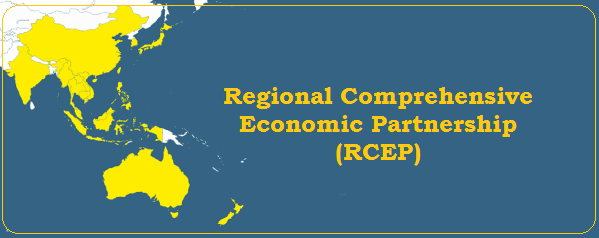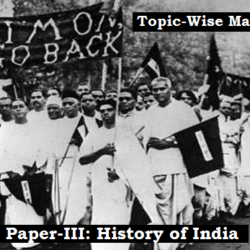
Regional Comprehensive Economic Partnership (RCEP) is a proposed free trade agreement (FTA) between the 10 member states of the Association of Southeast Asian Nations (ASEAN)– Brunei, Cambodia, Indonesia, Laos, Malaysia, Myanmar, the Philippines, Singapore, Thailand, Vietnam and ASEAN+3 counties (China, Japan, South Korea), EAS countries (India, Australia, New Zealand).
RCEP negotiations were formally launched in November 2012 at the ASEAN Summit in Cambodia. RCEP is viewed as an alternative to the Trans-Pacific Partnership (TPP), a proposed trade agreement which includes several Asian and American nations but excludes China and India.
| Table of Contents: |
| Present Status Significance Concerns for India Merits of India joining RCEP |
Present Status
- The negotiations on RCEP were last year extended into 2019 as the parties were unable to reach an agreement on key issues.
- Indian industry and the government have reservations on joining RCEP.
Significance
- The RCEP member countries represent 49% of the world’s population and accounts for 30% of world GDP. It also makes up 29% of world trade and 26% of world FDI inflows.
- RCEP will also reduce the overlapping between Asian FTAs.
- RCEP will reduce the trade barriers in Asia and the new rules will be consistent with WTO agreements.
- RCEP will promote easier FDI flows and technology transfers by multinational corporations
- With rise of protectionism, RCEP is important for promoting free trade in the region.
Concerns for India
- Trade Deficit with China:
- India has a trade deficit with ASEAN as well as the partner countries of RCEP and China alone accounts for 60% of the trade deficit.
- India’s trade with China is much skewed and lowering tariffs could lead to unrestricted imports into India with very limited access for Indian exports into the Chinese market.
- At a time of growing protectionism and US’s stance towards China, opening India’s market for China could have adverse impact on India’s economy.
- Impact on Agriculture and allied Activities:
- Agriculture and allied sector in India has already been facing adverse effects due to India-ASEAN FTA despite of relatively high protection of agriculture and a tariff-coverage of 73-80%.
- Under RCEP, if tariff cuts cover 92-80% of products, there will be adverse impact due to heating up of competition for Indian farmers
- Further, there are concerns that New Zealand’s export-oriented dairy products will negatively impact India’s growing dairy sector, which is largely small-scale.
- Impact on Manufacturing:
- There are concerns that RCEP will have adverse impact on Indian manufacturing sector while competing with cheaper products from ASEAN and China
- Further, Japan and South Korea has asked India to eliminate export restrictions on minerals and raw materials. This may threaten domestic raw material availability for industrialization and encourage over-mining.
- Indian experts opine that this would lead to a new form of Neo-colonialism.
- Issues related to Intellectual Property Rights and Health Sector:
- There are allegations that Japan and South Korea have been advocating for ‘TRIPS Plus’ IP protection regimes in the RCEP.
- A strong IPR regime based on patent term regime and data exclusivity will hinder India’s cheap supply of drugs, specially related to HIV/AIDS to developing countries, especially in Africa.
- Impact on E-commerce:
- The e-commerce rules in RCEP impose binding rules that will mandate India to give away data to large multinational companies.
- Critics opine that this would have privacy and security issues for not only individuals but also the government.
- Further, critics speculate that wholesale duty-free import of goods by e-commerce giants like Alibaba in China will threaten local products developed by SMEs and domestic job creation in those segments
- Demand for labour movement:
- At RCEP negotiations, India has demanded for both Mode 3 (investments) and Mode 4 (movement of people) with a RCEP business visa for professionals.
- However, RCEP countries like Australia and Singapore have been unwilling to accommodate India’s demands to liberalize their services regime and allow freer mobility of Indian workers
- Environment and labor reforms:
- Non-trade issues such as environment and labor need greater attention. While many Countries in RCEP want a stricter norms and standards on environment and labor issues while India’s interest lie in liberal environment and labor norms as this makes Indian industry competitive.
- India therefore should bat for liberal environment and labor norms while negotiating in RCEP.
Merits of India joining RCEP
- Prevent negative impacts of mega trade agreements:
- It would enable India to strengthen its trade ties with Australia, China, Japan and South Korea and thus reduce the potential negative impacts of TPP and TTIP on the Indian economy as India is not a part of any large trade agreements.
- Deadlock in WTO negotiations:
- Issues with multilateralism under the aegis of WTO; Regional Trade Agreements are quick to negotiate, catering the needs of a nation.
- The rise in protectionism and non- tariff barriers and regulatory measures and the deadlock in WTO negotiations are also important reasons for India to join the RCEP agreement as it can increase market access.
- Accordance with India’s Act East Policy:
- RCEP also has the potential to influence India’s strategic and economic status in the Asia-Pacific region and help in fulfillment of India’s Act East Policy.
- Diversification of trade
- Diversification of trade, less dependence on weakening Euro zone and western markets
- Removes the fear of China about India joining US pivot to Asia.
- Development of North Eastern States:
- Better development of North Eastern state due to proximity- less insurgency, better integration

 Home
Home Syllabus
Syllabus Contact Us
Contact Us




